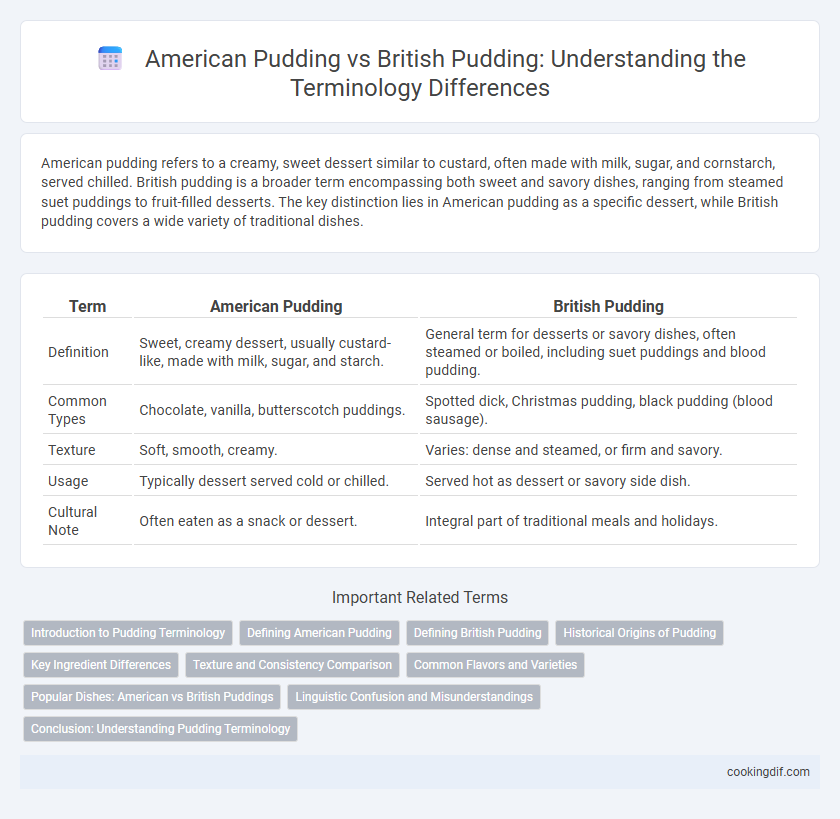American pudding refers to a creamy, sweet dessert similar to custard, often made with milk, sugar, and cornstarch, served chilled. British pudding is a broader term encompassing both sweet and savory dishes, ranging from steamed suet puddings to fruit-filled desserts. The key distinction lies in American pudding as a specific dessert, while British pudding covers a wide variety of traditional dishes.
Table of Comparison
| Term | American Pudding | British Pudding |
|---|---|---|
| Definition | Sweet, creamy dessert, usually custard-like, made with milk, sugar, and starch. | General term for desserts or savory dishes, often steamed or boiled, including suet puddings and blood pudding. |
| Common Types | Chocolate, vanilla, butterscotch puddings. | Spotted dick, Christmas pudding, black pudding (blood sausage). |
| Texture | Soft, smooth, creamy. | Varies: dense and steamed, or firm and savory. |
| Usage | Typically dessert served cold or chilled. | Served hot as dessert or savory side dish. |
| Cultural Note | Often eaten as a snack or dessert. | Integral part of traditional meals and holidays. |
Introduction to Pudding Terminology
American pudding typically refers to a sweet, creamy dessert similar to custard, made with milk, sugar, and a thickening agent like cornstarch. In contrast, British pudding is a broader term encompassing both sweet and savory dishes, often steamed or boiled, such as Yorkshire pudding or black pudding. Understanding these regional differences is essential for accurate communication and recipe interpretation in culinary contexts.
Defining American Pudding
American pudding refers to a sweet, creamy dessert made from milk, sugar, and a thickening agent such as cornstarch, differing significantly from British pudding, which encompasses a variety of steamed or baked dishes that can be sweet or savory. Unlike British puddings, which include items like Christmas pudding or black pudding, American pudding is similar in texture to custard and is often served chilled. The term "pudding" in the United States primarily denotes this smooth, spoonable dessert rather than any steamed or savory preparation.
Defining British Pudding
British pudding refers to a broad category of dishes, including both savory and sweet varieties, characterized by the use of ingredients like suet, breadcrumbs, and flour, traditionally steamed or boiled. Unlike American pudding, which is a creamy, custard-like dessert made from milk, sugar, and thickening agents such as cornstarch or gelatin, British puddings can encompass items like black pudding (a type of blood sausage) and Yorkshire pudding (a baked batter side dish). The term "pudding" in the UK often denotes more than just dessert, reflecting a cultural and culinary distinction rooted in historical cooking methods and regional ingredients.
Historical Origins of Pudding
American pudding evolved from 19th-century custard desserts, typically smooth and creamy, made with milk, sugar, and cornstarch or gelatin as a thickener. British pudding traces its origins to medieval savory and sweet dishes cooked by boiling or steaming, ranging from meat-filled haggis to suet-based steamed puddings like treacle tart. The divergence in terminology reflects distinct culinary traditions shaped by historical food preparation methods and regional ingredient availability.
Key Ingredient Differences
American pudding is primarily a sweet, creamy dessert made from milk, sugar, and a thickening agent like cornstarch or gelatin, often flavored with chocolate or vanilla. British pudding encompasses a broader category of dishes, including both sweet and savory varieties, with key ingredients ranging from suet and breadcrumbs in steamed puddings to dried fruits in Christmas pudding. The fundamental distinction lies in American pudding's emphasis on dairy-based custards versus British pudding's use of diverse ingredients and cooking methods, reflecting regional culinary traditions.
Texture and Consistency Comparison
American pudding typically features a smooth, creamy texture similar to custard, achieved through the use of starch-thickened milk mixtures. In contrast, British pudding encompasses a broader range of dishes with varying textures, from dense and steamed suet puddings to lighter sponge-like varieties. The American version emphasizes a uniform, silky consistency, while British puddings display diverse textures due to different cooking methods and ingredients.
Common Flavors and Varieties
American pudding typically refers to a creamy, sweet custard-like dessert made from milk, sugar, and cornstarch, with common flavors including chocolate, vanilla, and butterscotch. British pudding encompasses a broader range of dishes, often steamed or boiled, with varieties such as suet puddings, sticky toffee pudding, and black pudding, the latter being a savory blood sausage. While American pudding highlights smooth, dairy-based textures, British pudding emphasizes diverse preparations ranging from sweet to savory.
Popular Dishes: American vs British Puddings
American pudding refers to a creamy, sweet dessert often made from milk, sugar, and cornstarch, with popular flavors like chocolate, vanilla, and butterscotch. In contrast, British pudding encompasses a broader category, including both sweet desserts such as sticky toffee pudding and savory dishes like black pudding or steak and kidney pudding. Key distinctions highlight that American pudding is primarily a custard-like dessert, while British pudding can be a steamed, baked, or boiled dish served as either a dessert or main course.
Linguistic Confusion and Misunderstandings
American pudding refers to a sweet, creamy dessert similar to custard, whereas British pudding encompasses a broader category including savory dishes and steamed desserts. This linguistic difference causes confusion in culinary contexts, as ordering "pudding" in the UK often implies a rich, dense dish rather than a soft dessert. Understanding these distinct meanings is essential to avoid misunderstandings in international food communication.
Conclusion: Understanding Pudding Terminology
American pudding typically refers to a creamy, sweet dessert similar to custard, made with milk, sugar, and a thickening agent like cornstarch, often served chilled. British pudding encompasses a broader range of dishes, including both sweet desserts and savory steamed or boiled foods, such as suet puddings and black pudding. Understanding these regional differences in pudding terminology is essential for clear communication and avoiding culinary misunderstandings.
American pudding vs British pudding for terminology Infographic

 cookingdif.com
cookingdif.com